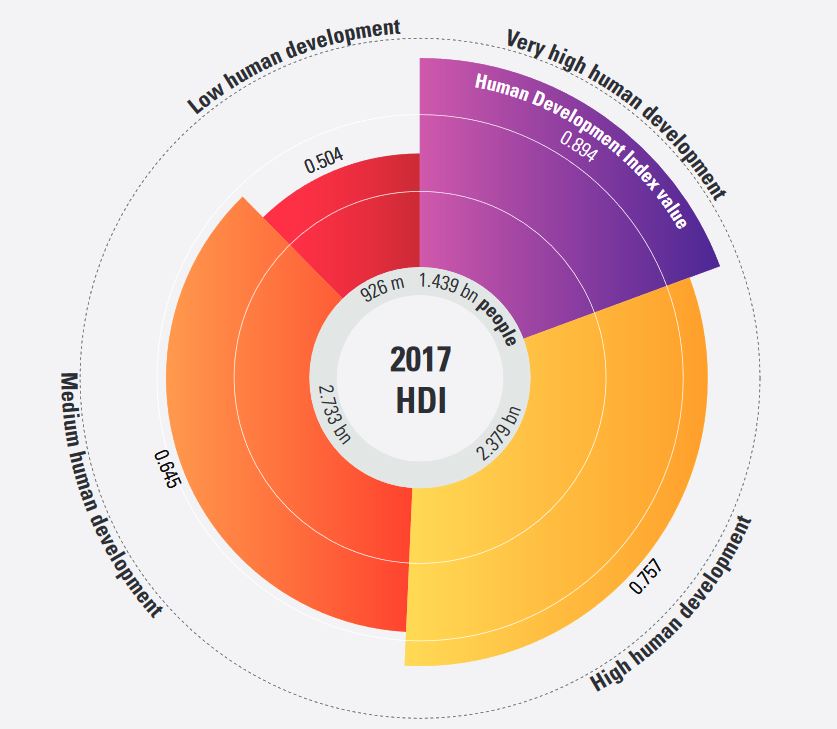The latest Human Development Report, published in September, is a key fixture for educators and activists published by the UN Development Programme annually, is packed with graphics, ideas and statistics. Colm Regan dips into the key human development indices and statistics from the report which provides an overview of the state of development across the world.

- Ireland enjoyed the highest increase in the Human Development Index (HDI which measures national achievements in health, education and income) rank between 2012 and 2017 moving up 13 places and now ranks 4th in the world.
- The three steepest declines in human development ranking were countries in conflict: the Syrian Arab Republic had the largest decrease in HDI rank, falling 27 places, followed by Libya (26 places), and Yemen (20 places).
- The overall trend globally is toward continued human development improvements, with many countries moving up through the human development categories: out of the 189 countries for which the HDI is calculated, 59 countries are today in the very high human development group and only 38 countries fall in the low HDI group. Just eight years ago in 2010, the figures were 46 and 49 countries respectively. But there remain massive differences across the world in people’s well-being.
- ‘On average, a child born today in a country with low human development can expect to live just over 60 years, while a child born in a country with very high human development can expect to live to almost 80. Similarly, children in low human development countries can expect to be in school seven years less than children in very high human development countries’ – Achim Steiner UNDP Administrator.
- In Sub-Saharan Africa there are on average 39 primary school pupils per teacher while in OECD countries, East Asia and the Pacific, Europe and Central Asia there is an average of one teacher for every 16-18 pupils. In OECD countries, East Asia and the Pacific there are on average 29 and 28 physicians for every 10,000 people whereas in South Asia there are only eight, and in Sub-Saharan Africa not even two.
According to the latest Human Development Index (September 14th, 2018) people living in the very high human development countries can expect to live 19 years longer, and spend seven more years in school, than those living in the group of low human development countries.
Six Key Findings from the 2018 Index
1. The World has made impressive progress in human development
Looking back over almost three decades, all regions and human development groups have made substantial progress. The global HDI value in 2017 was up about 21.7 percent from 1990. Across the world, people are living longer, are more educated and have greater opportunities.
2. Quality, not just quantity of human development, is important, and it reveals large deficits
Most people today live longer, are more educated and have more access to goods and services than ever before. But living longer does not automatically mean more years spent enjoying life. For example, healthy life expectancy for countries of very high human development is approximately 70 years, whereas for countries of low human development it is approximately 53 years
3. Progress is not linear or guaranteed, and crises and challenges can reverse gains. Countries experiencing conflict show HDI losses, which can be felt for generations
Between 2012 and 2017 Libya, the Syrian Arab Republic and Yemen had falling HDI values and ranks – the direct effect of violent conflict. Although Lebanon is not directly involved in violent conflict, it has suffered spillovers from the conflict in Syria, hosting more than a million Syrian refugees.
4. Disparities between and within countries continue to stifle progress
Average HDI levels have risen significantly since 1990 – 22 percent globally and 51 percent in least developed countries. But there remain massive differences across the world in people’s well-being.
5. Gender gaps in early years are closing, but inequalities persist in adulthood
One key source of inequality within countries is the gap in opportunities, achievements and empowerment between women and men. Worldwide the average HDI for women is six percent lower than for men, due to women’s lower income and educational attainment in many countries.
6. Environmental degradation puts human development gains at risk
The degradation of the environment and atmosphere, coupled with significant declines in biodiversity, is linked to other development concerns ranging from declining food and water supplies to losses of livelihood and life from extreme weather events. This profoundly serious crisis threatens the human development of current and future generations.
And, on inequality
While significant inequality occurs in many countries, including in some of the wealthiest ones, on average it takes a bigger toll on countries with lower human development levels. Low and medium human development countries lose respectively 31 and 25 percent of their human development level from inequality, while for very high human development countries, the average loss is 11 percent.
While these statistics present a stark picture in themselves, they also speak to the tragedy of millions of individuals whose lives are affected by inequity and lost opportunities, neither of which are inevitable.
- Read the Human Development Indices and Indicators: 2018 Statistical Update at https://report.hdr.undp.org
- Read the news release from the, Wide inequalities in people’s well-being cast a shadow on sustained human development progress (September 14, 2018) published on the UNDP website

